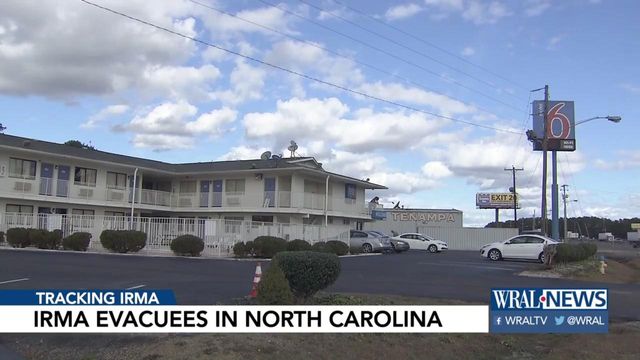Copy
The National Hurricane Center at 5 a.m. Saturday had Hurricane Irma on a path that put all of Florida at risk and tracked north and west of Atlanta and into Tennessee, just brushing the North Carolina mountains. At that time, the storm, a Category 4 hurricane, was moving west-northwest at 12 mph with maximum sustained winds of 155 mph. The latest track calls for landfall near Fort Meyers in southwest Florida on Monday.
Posted — UpdatedThe National Hurricane Center at 5 a.m. Saturday had Hurricane Irma on a path that put all of Florida at risk and tracked north and west of Atlanta and into Tennessee, just brushing the North Carolina mountains. At that time, the storm, a Category 4 hurricane, was moving west-northwest at 12 mph with maximum sustained winds of 155 mph. The latest track calls for landfall near Fort Meyers in southwest Florida on Monday.
Most of the Tar Heel State is outside the threat of severe weather from Hurricane Irma. The most likely impacts close to home will come in the southwest mountains, WRAL meteorologist Mike Moss said. Cities like Asheville could see flash flooding as early as Monday.
While many of the state's poor have little choice but to stay put at home or head to a shelter, some people who can choose are opting to ride the storm out rather than risk driving hundreds of miles north with no sure source of gasoline or accommodations.
"I have two choices, stay or run north, a bad idea" said Michel Polette, 31, who lives a couple of blocks from the Atlantic Ocean in South Beach. "If you drive to Atlanta or Tallahassee, you're risking running out of gas and being in your car in a Category 4 hurricane."
Residents at the Treasure Village Mobile Home Park in St. Petersburg, about four hours northwest of Miami Beach, said they weren't leaving either — even though the county called for an evacuation of all mobile homes, regardless of whether they were inland or near the water.
Making the decision to stay is often made by people who feel they have a strong social support system who will help them through the hardship, a study published by the American Meteorological Society earlier this year found. The study was based on data gathered during 2016's Hurricane Matthew, which flooded northeast Florida, destroying homes in St. Augustine and the surrounding area with floodwaters.
"We got the opposite results from what I expected because those who stayed and who were under mandatory evacuation, they had more dependable social networks than those who evacuated," said Jennifer Collins, one of the University of South Florida researchers who conducted the study. "Their neighborhoods and local communities — they felt very comfortable to hunker down with them."
Some people in Miami felt mixed about their decision to stay put, but were influenced to do so by special circumstances, like pregnancy.
Stefani Travieso, 22, lives in a Miami neighborhood that was badly damaged during Hurricane Andrew in 1992. She is eight months pregnant and her doctor told her to stay in a comfortable place where she felt safe. Since Andrew her roof has been replaced, and storm windows installed along with a backup generator.
"If I wasn't pregnant, I'd be in the car headed north with my dog and my husband," she said.
Copyright 2024 by WRAL.com and the Associated Press. All rights reserved. This material may not be published, broadcast, rewritten or redistributed.






